Health Care > QUESTIONS & ANSWERS > RN Targeted Medical Surgical Endocrine Online Practice 2019 (Graded A) (All)
RN Targeted Medical Surgical Endocrine Online Practice 2019 (Graded A)
Document Content and Description Below
A nurse is teaching a client who has diabetes mellitus about insulin injections. The client's prescription includes evening doses of insulin glargine and regular insulin. Which of the following instru... ctions should the nurse include? a. Inject the insulins intramuscularly. b. Shake the insulins vigorously prior to administration. c. Draw up the insulins into separate syringes. d. Expect the insulins to appear cloudy. - ANSWER Draw up the insulins into separate syringes. The nurse should instruct the client to draw up the insulins into separate syringes because insulin glargine is not compatible with other insulins. A nurse is planning teaching for a client who has type 1 diabetes mellitus. Which of the following instructions should the nurse include? a. Consume no more than three servings of alcohol per day. b. Ingest food with alcohol to reduce alcohol-induced hypoglycemia. c. Increase insulin dosage before planned exercise. d. Rest for 3 days between periods of vigorous exercise. - ANSWER Ingest food with alcohol to reduce alcohol-induced hypoglycemia. Alcohol inhibits the liver from producing glucose. Consuming carbohydrates while drinking alcoholic beverages helps prevent hypoglycemia. A nurse is caring for a client who has a pheochromocytoma. Which of the following actions should the nurse take? a. Elevate the head of the client's bed. b. Palpate the client's abdomen. c. Monitor the client for hypotension. d. Check the client's urine specific gravity. - ANSWER Elevate the head of the client's bed. The nurse should elevate the head of the client's bed to reduce blood pressure and abdominal pressure. A nurse has administered propranolol by IV bolus to a client who is having a thyroid storm. Which of the following findings indicates that the client is having a therapeutic response? a. Reduction of the effects of thyroid hormone on the heart b. Blockage of the release of thyroid hormone from the thyroid gland c. Increase in the heart's sensitivity to thyroid hormone d. Increase in the uptake of thyroid hormone by the thyroid gland - ANSWER Reduction of the effects of thyroid hormone on the heart Propranolol is a beta2-adrenergic blocking agent that decreases the rapid heart rate that excessive thyroid stimulation causes. A nurse is monitoring a client's status 24 hours after a total thyroidectomy. Which of the following findings should the nurse report to the provider? a. Laryngeal stridor b. Productive cough c. Pain with hyperextension of the neck d. Hoarse, weak voice - ANSWER Laryngeal stridor Laryngeal stridor is a harsh, high-pitched sound with inspiration that indicates respiratory obstruction. The nurse should take immediate action to preserve the client's airway. A nurse is teaching a client who has an autoimmune disease about the adverse effects of long-term corticosteroid therapy. Which of the following effects should the nurse include? (select all that apply) a. Osteoporosis b. Moon-shaped face c. Increased risk of infection d. Hearing loss e. Weight loss - ANSWER -Osteoporosis -Moon-shaped face -Increased risk of infection Osteoporosis is correct. Osteoporosis is an adverse effect of long-term corticosteroid therapy due to the suppression of bone formation and the acceleration of bone resorption that corticosteroid therapy can cause. Moon-shaped face is correct. Long-term corticosteroid therapy causes characteristics of iatrogenic Cushing's syndrome, including a moon-shaped face, a potbelly, and a buffalo hump. Increased risk of infection is correct. Increased risk of infection is an adverse effect of long-term corticosteroid therapy due to suppression of the immune system. It reduces the phagocytic actions of macrophages and neutrophils, thus increasing the risk of infection. Hearing loss is incorrect. Long-term corticosteroid therapy can cause cataracts and glaucoma, but it does not cause hearing loss. Weight loss is incorrect. Long-term corticosteroid therapy is more likely to cause weight gain due to the fluid and sodium retention these medications cause. A nurse is caring for a client who has type 2 diabetes melliltus and has hyperglycemic-hyperosmolar state (HHS). Which of the following laboratory findings should the nurse expect? a. Serum pH 7.32 b. Blood glucose 250 mg/dL c. Blood glucose 425 mg/dL d. Serum pH 7.45 - ANSWER Serum pH of 7.45 A client who has HHS produces enough insulin to prevent ketosis, but not enough to prevent hyperglycemia. Therefore, the serum pH is within the expected reference range. Glucose levels will be above 600 mg/dL. To screen a client for pheochromocytoma, a nurse schedules a vanillylmandelic acid test. When teaching the client about this test, which of the following instructions should the nurse include? a. "Start fasting at midnight prior to the day of the test." b. "Begin the 24-hour urine collection with the first morning urination." c. "Take low-dose aspirin for pain during the testing period." d. "Restrict coffee intake 2 to 3 days prior to the test." - ANSWER "Restrict coffee intake 2 to 3 days prior to the test." The client should avoid coffee and tea (even if they are decaffeinated), bananas, chocolate, and vanilla for 2 to 3 days prior to the test. A nurse in an outpatient clinic is teaching a client who has a diabetic foot ulcer about foot care. Which of the following statements should the nurse identify as an indication that the client understands the teaching? a. "I will let my feet air dry after washing." b. "I will wear sandals to allow air to circulate around my feet." c. "I will buy over-the-counter medicine to treat the calluses on my feet." d. "I will apply lotion to the dry areas of my feet but not between my toes." - ANSWER "I will apply lotion to the dry areas of my feet, but not between my toes." Lotion can be used for dry areas of the feet, but the client should avoid applying lotion between the toes, as this area is prone to bacterial growth. A nurse is teaching a client who has diabetes mellitus. Which of the following should the nurse include as an expected finding of diabetic ketoacidosis (DKA)? a. Decreased urine output b. Weight gain of 0.45 kg (1 lb) in 24 hr c. Rapid, shallow respirations d. Blood glucose levels above 300 mg/dL - ANSWER Blood glucose levels above 300 mg/dL Blood glucose levels above 300 mg/dL are an expected finding with DKA. Levels above 600 mg/dL are an expected finding with hyperglycemic-hyperosmolar state. A nurse is admitting a client who has hyperthyroidism. When assessing the client, the nurse should expect which of the following findings? a. Cold intolerance b. Lethargy c. Tremors d. Sunken eyes - ANSWER Tremors Findings of hyperthyroidism include tremors, diaphoresis, and insomnia. A nurse is developing a teaching plan for a client who had a thyroidectomy and takes a thyroid hormone replacement. Which of the following instructions should the nurse plan to include? a. "Take this medication on an empty stomach." b. "Take this medication with an antacid." c. "Change position slowly while taking this medication." d. "Limit your fluid intake while taking this medication." - ANSWER "Take this medication on an empty stomach." To promote proper absorption, the client should take the medication on an empty stomach and not eat or drink anything for 30 to 60 min after taking it. A nurse is caring for a client who is taking propylthiouracil. The nurse should identify that the client has met the treatment goals when she reports an increase in which of the following manifestations? a. Increased ability to sweat b. Increased bowel movements c. Increased body weight d. Increased libido - ANSWER Increased body weight Propylthiouracil suppresses the production of thyroid hormones and, therefore, allows for weight gain. However, excessive weight gain could indicate that the dose of propylthiouracil is too high A nurse is caring for a client following a thyroidectomy. The nurse should assess for which of the following findings as an indication of hypocalcemia? a. Strong, bounding pulse b. Decreased bowel sounds c. Tingling and numbness of the hands and feet d. Diminished deep-tendon reflexes - ANSWER Tingling and numbness of the hands and feet Hypocalcemia causes paresthesias, which usually starts in the hands and feet. A nurse is preparing a teaching plan for a client who has diabetes insipidus and requires intranasal desmopressin. Which of the following information should the nurse include in the teaching plan? a. "Drink at least 3 liters of fluid per day." b. "Weigh yourself weekly while wearing similar clothing at the same time of day." c. "Notify the provider of a weight loss of 1 pound or more per week." d. "Report nocturia because it requires a dosage adjustment." - ANSWER Report nocturia because it requires a dosage adjustment. The client should receive the initial dose of desmopressin in the evening; the provider will increase the dosage until the client no longer has nocturia. A nurse is caring for a client undergoing screening for primary Cushing's disease. The nurse should expect an elevation in which of the following laboratory findings? a. Lymphocyte count b. Potassium c. Calcium d. Glucose - ANSWER Glucose Blood glucose is elevated in a client who has Cushing's disease. A nurse is caring for a client who has diabetes mellitus and has developed peripheral neuropathy. Which of the following measures should the nurse recommend to prevent injuries to the client's feet? a. Examine the skin of the feet feet weekly for alterations in skin integrity. b. Monitor the temperature of bath water with a thermometer. c. Shop for shoes early in the day. d. Round the edges of toenails when trimming them. - ANSWER Monitor the temperature of bath water with a thermometer. Peripheral neuropathy makes it difficult to determine if bath water is too hot. Therefore, to prevent injury, the client should use a bath thermometer to ensure a water temperature below 43.3° C (110° F). A nurse is assessing a client who has syndrome of inappropriate antidiuretic hormone (SIADH). Which of the following findings should the nurse report to the provider? a. Sodium 110 mEq/L b. 2+ deep-tendon reflexes c. Potassium 3.7 mEq/L d. Urine specific gravity 1.025 - ANSWER Sodium 110 mEq/L A client who has SIADH retains fluids, which causes dilutional hyponatremia. A nurse is reviewing laboratory values for a client who has diabetic ketoacidosis (DKA). Which of the following results should the nurse expect? a. pH 7.32, PaCO2 36 mm Hg, HCO3- 14 mEq/L b. pH 7.38, PaCO2 55 mm Hg, HCO3- 22 mEq/L c. pH 7.44, PaCO2 40 mm Hg, HCO3- 24 mEq/L d. pH 7.50, PaCO2 42 mm Hg, HCO3- 30 mEq/L - ANSWER pH 7.32, PaCO2 36 mm Hg, HCO3- 14 mEq/L Metabolic acidosis is a common manifestation of DKA, with pH characteristically low, carbon dioxide within the expected reference range, and bicarbonate low. A nurse is assessing a client who has adrenal insufficiency. Which of the following findings should the nurse expect? a. Moon-shaped face b. Weight gain c. Calcium 12.8 mg/dL d. Sodium 150 mEq/L - ANSWER Calcium 12.8 mg/dL A client who has adrenal insufficiency has a calcium level above the expected reference range. A nurse is assessing a client who has a new diagnosis of Cushing's disease. Which of the following findings should the nurse expect? a. Decreased blood pressure b. Weight loss c. Hirsutism d. Increased skin thickness - ANSWER Hirsutism Increased hair growth, or hirsutism, is an expected finding of Cushing's disease due to increased androgen production. A nurse is monitoring the laboratory values of a client who has diabetes mellitus and is taking insulin. Which of the following results indicates a therapeutic outcome of insulin therapy? a. Fasting blood glucose 96 mg/dL b. Postprandial blood glucose 195 mg/dL c. Random blood glucose 210 mg/dL d. Preprandial blood glucose 60 mg/dL - ANSWER Fasting blood glucose 96 mg/dL This is within the expected reference range for a fasting blood glucose level and indicates that insulin therapy is effective. A nurse is assessing a client who has diabetes mellitus and reports feeling anxious. Which of the following findings should the nurse expect if the client is hypoglycemic? a. Rapid, deep respirations b. Cool, clammy skin c. Abdominal cramping d. Orthostatic hypotension - ANSWER Cool, clammy skin Hypoglycemia causes cool, clammy skin, in addition to anxiety, nervousness, tachycardia, and confusion. A nurse is managing the care of a client who is postoperative and has acute adrenal insufficiency. Which of the following actions should the nurse take? a. Administer IV hydrocortisone sodium. b. Give oral spironolactone. [Show More]
Last updated: 1 year ago
Preview 1 out of 11 pages
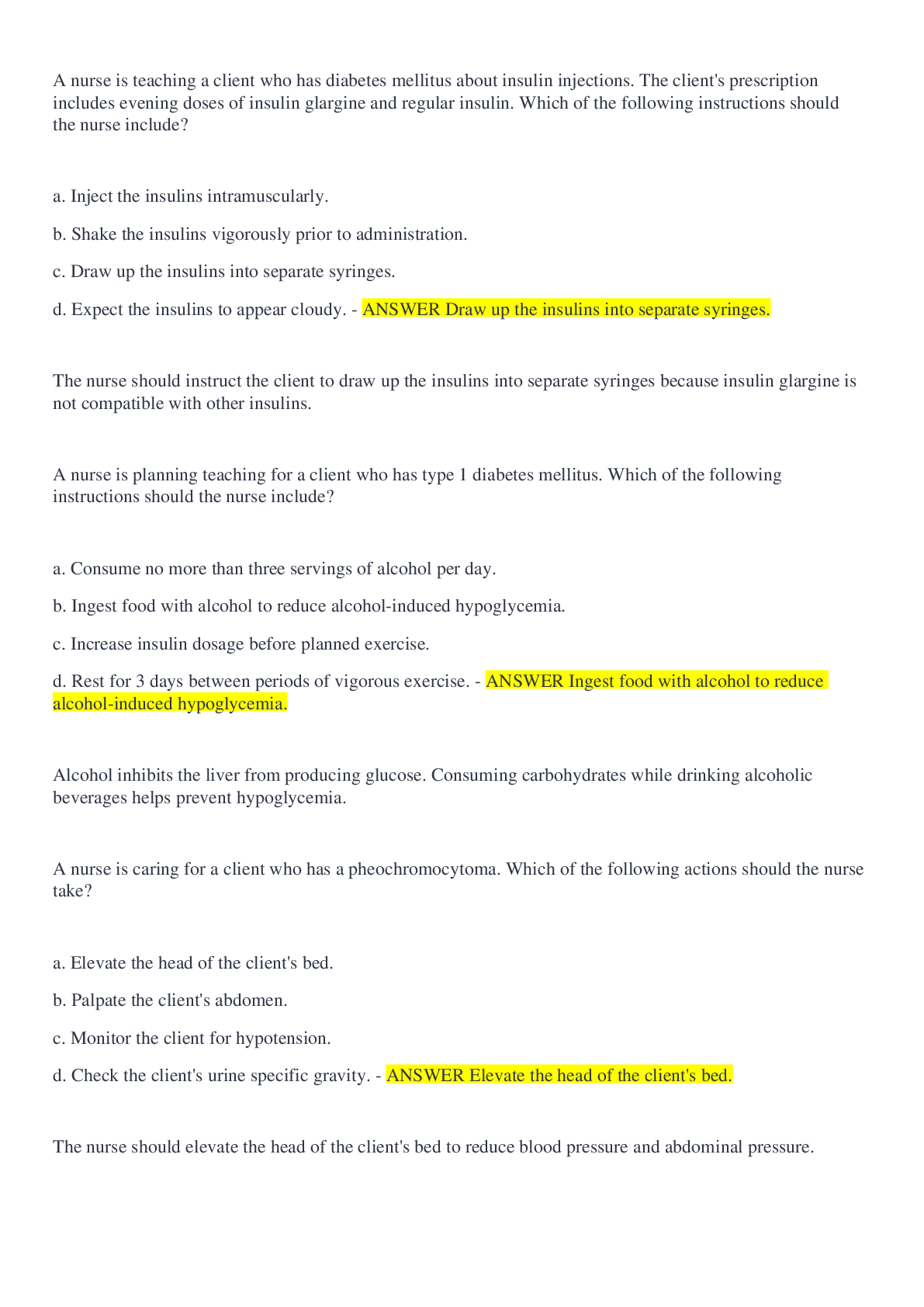
Reviews( 0 )
Document information
Connected school, study & course
About the document
Uploaded On
Aug 01, 2022
Number of pages
11
Written in
Additional information
This document has been written for:
Uploaded
Aug 01, 2022
Downloads
0
Views
46

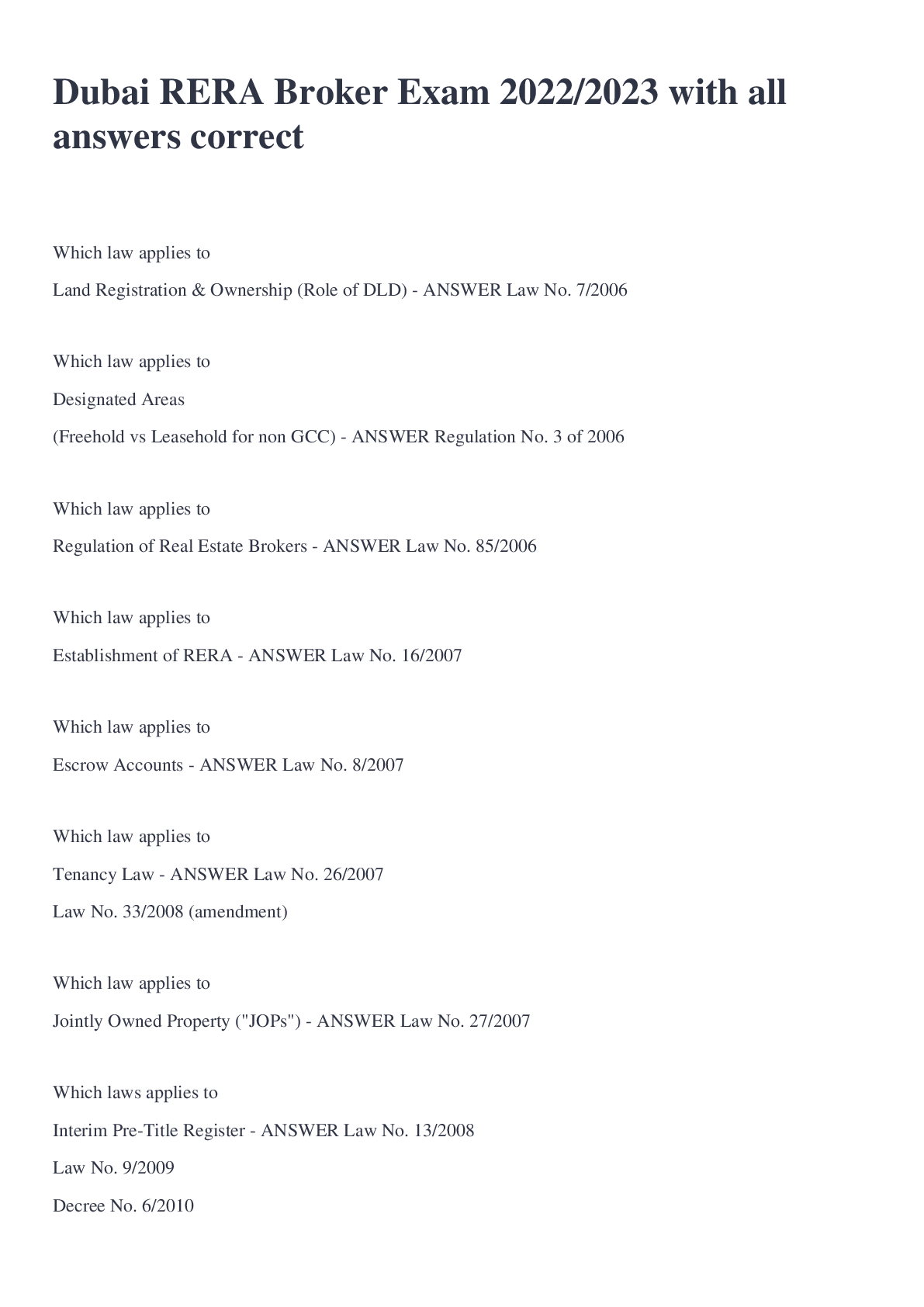
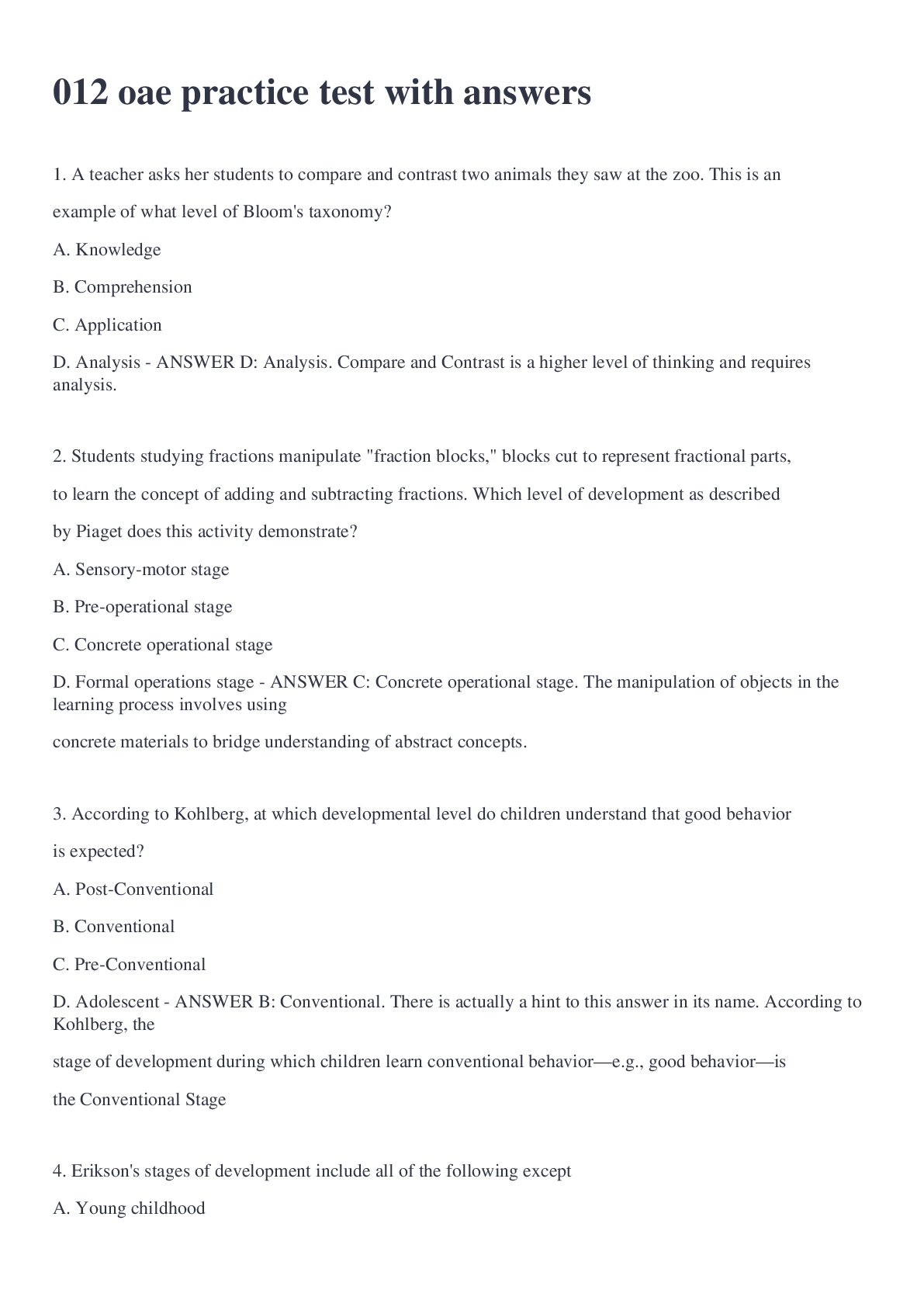
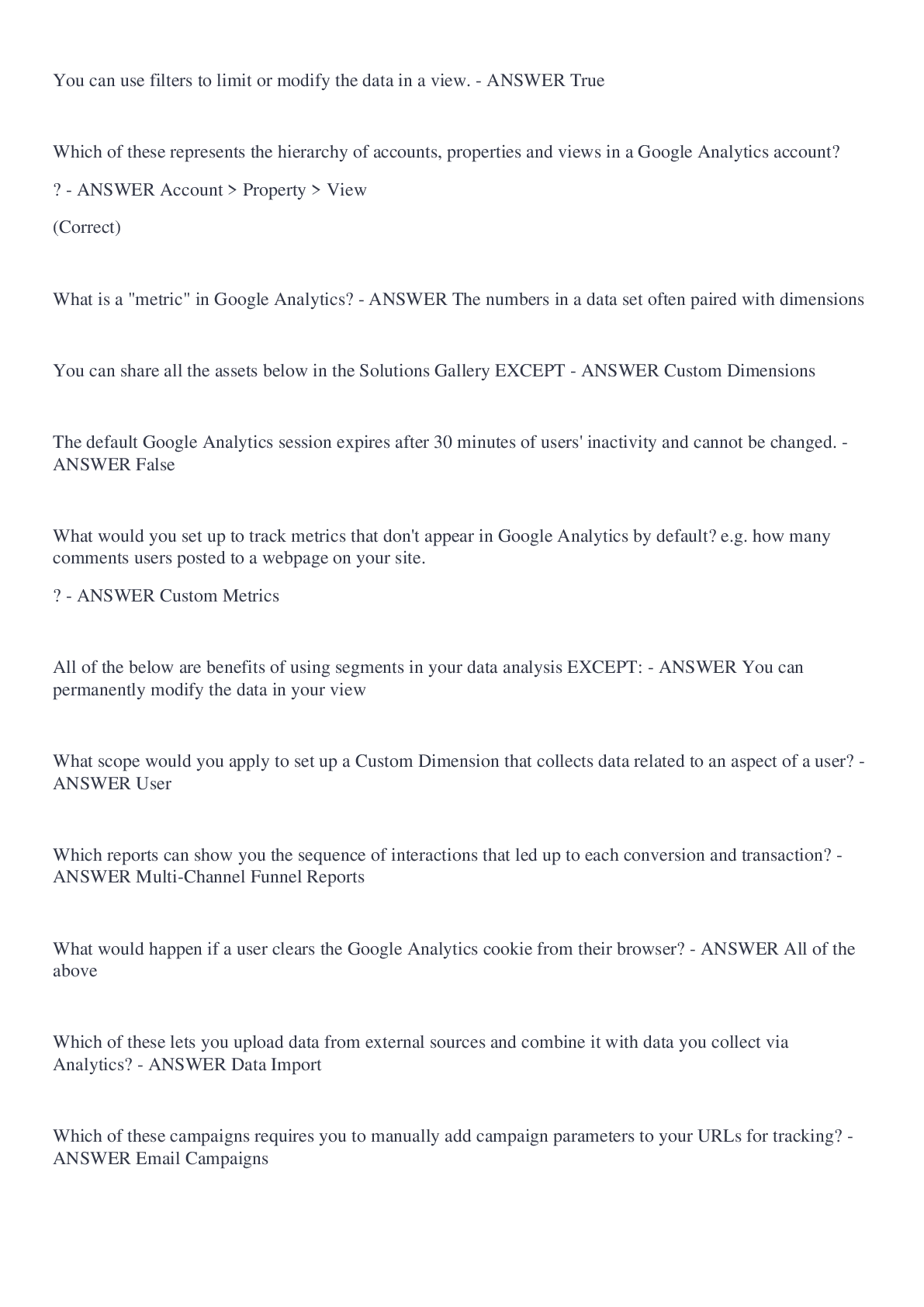
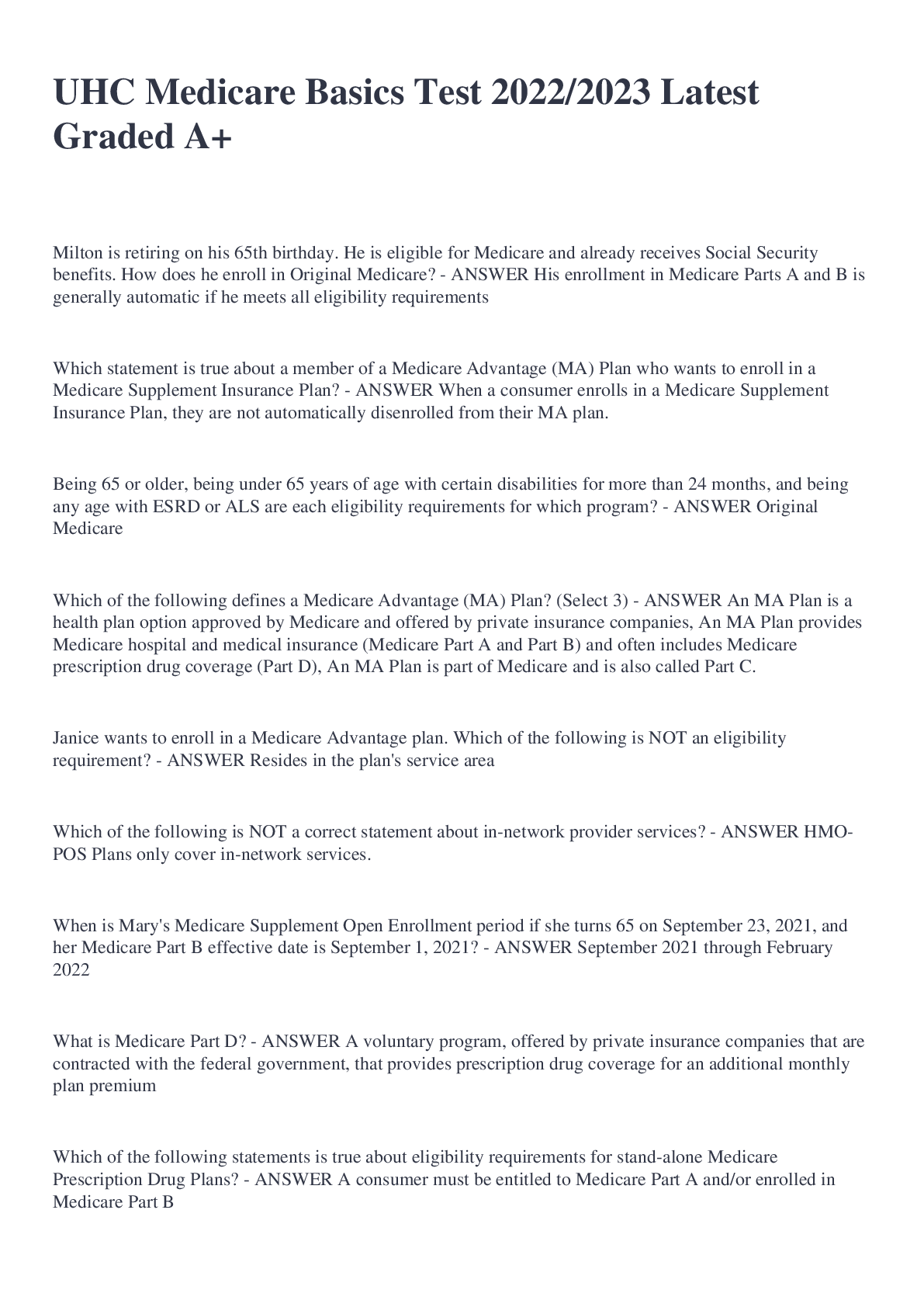
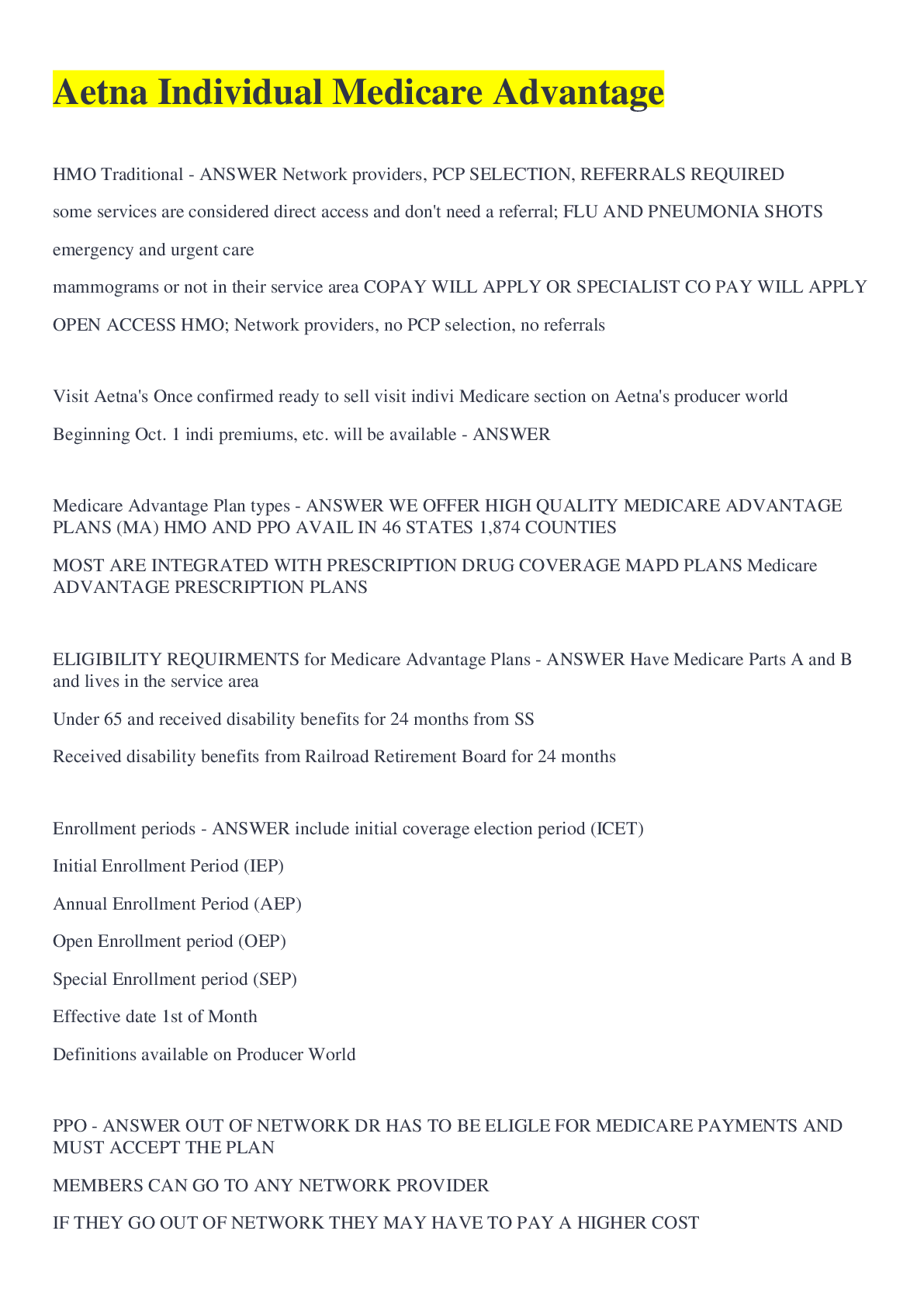

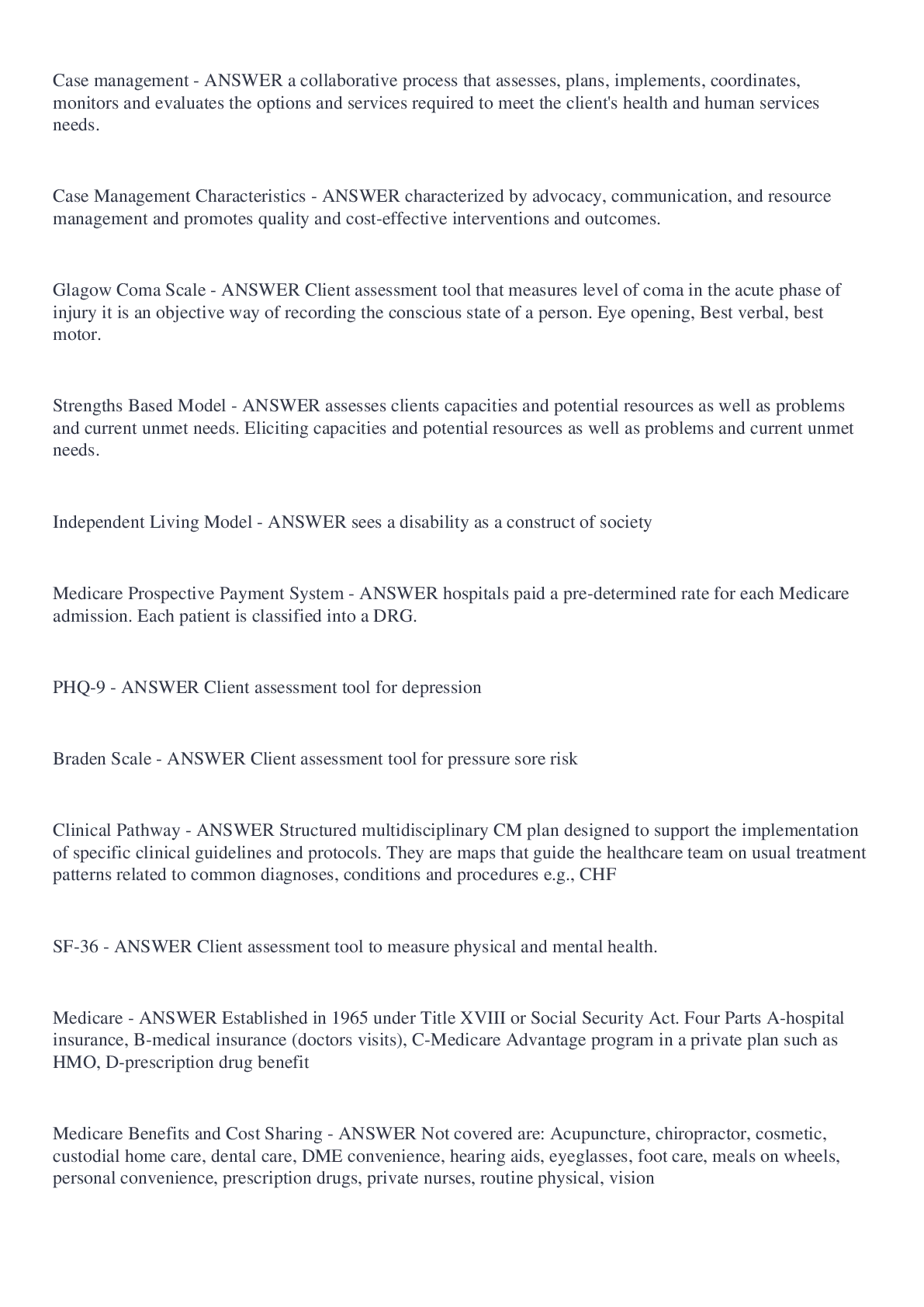
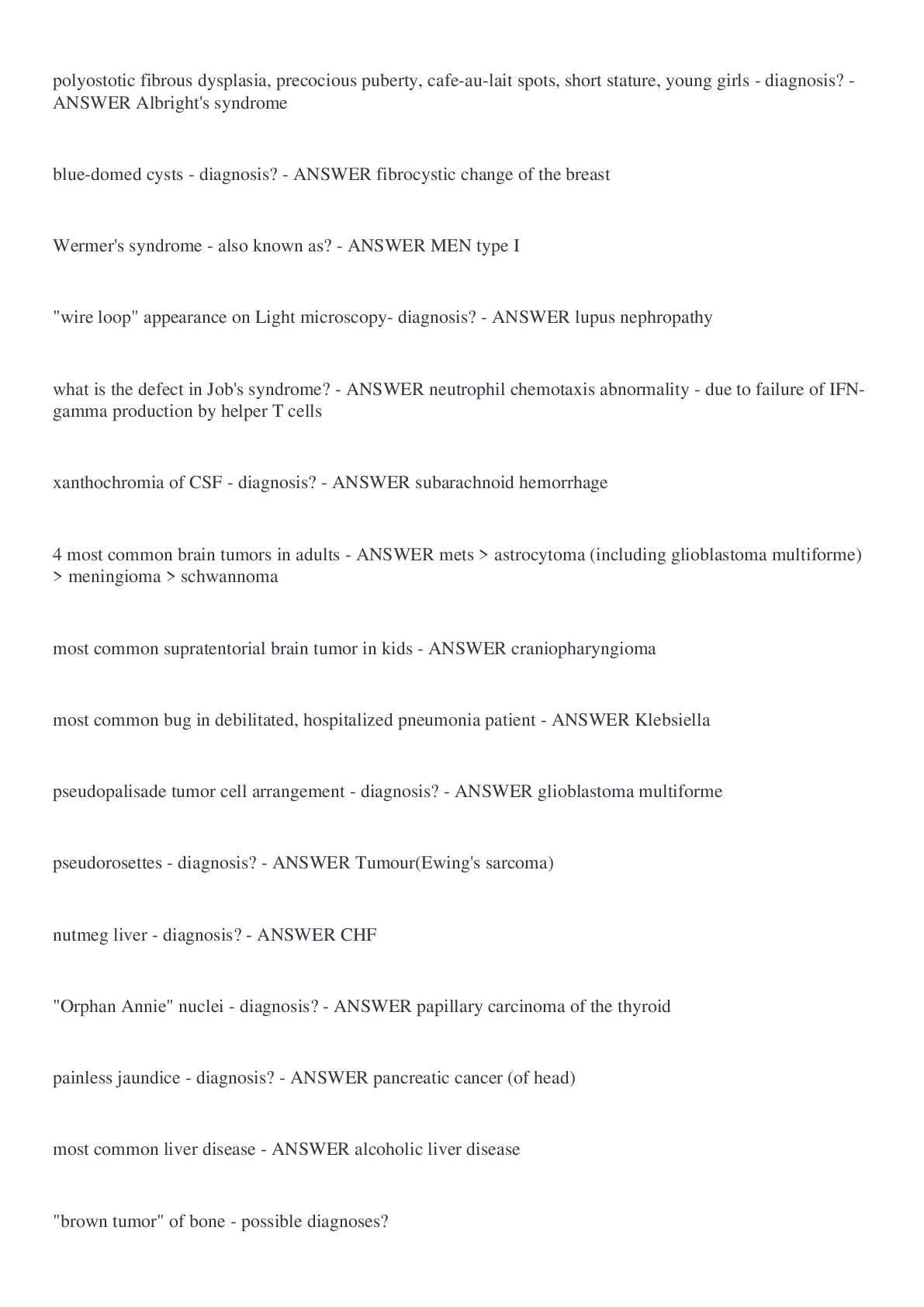
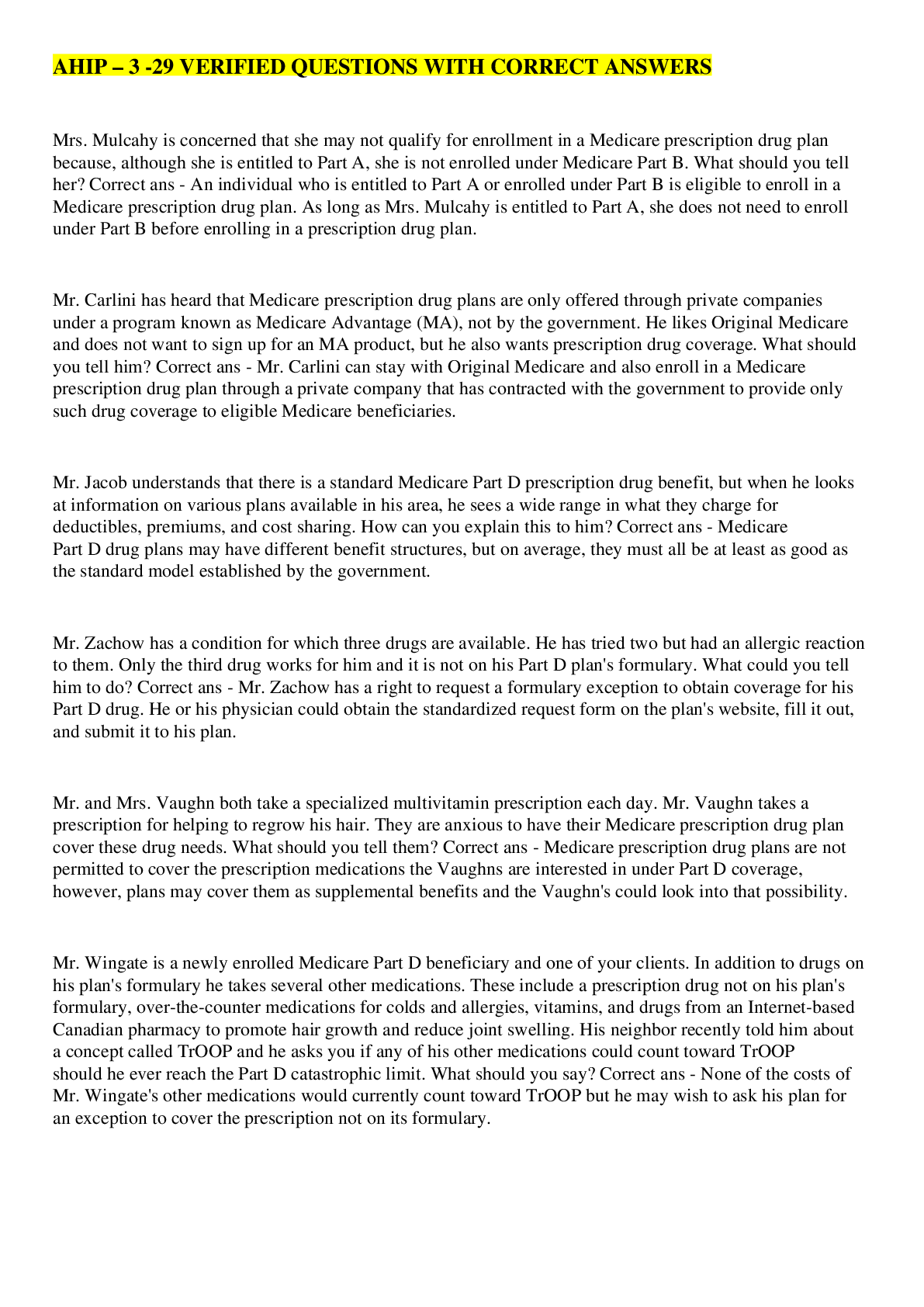
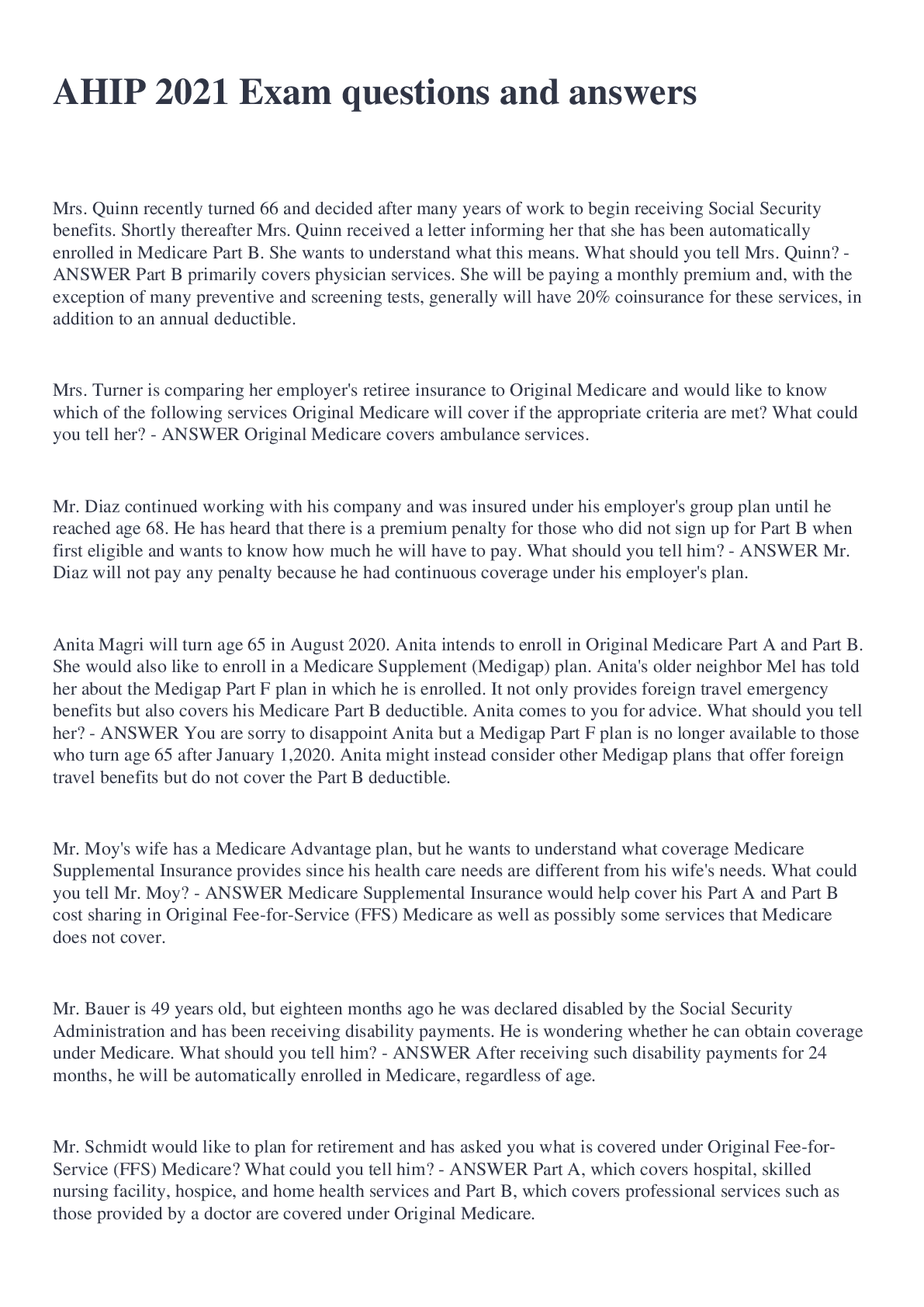
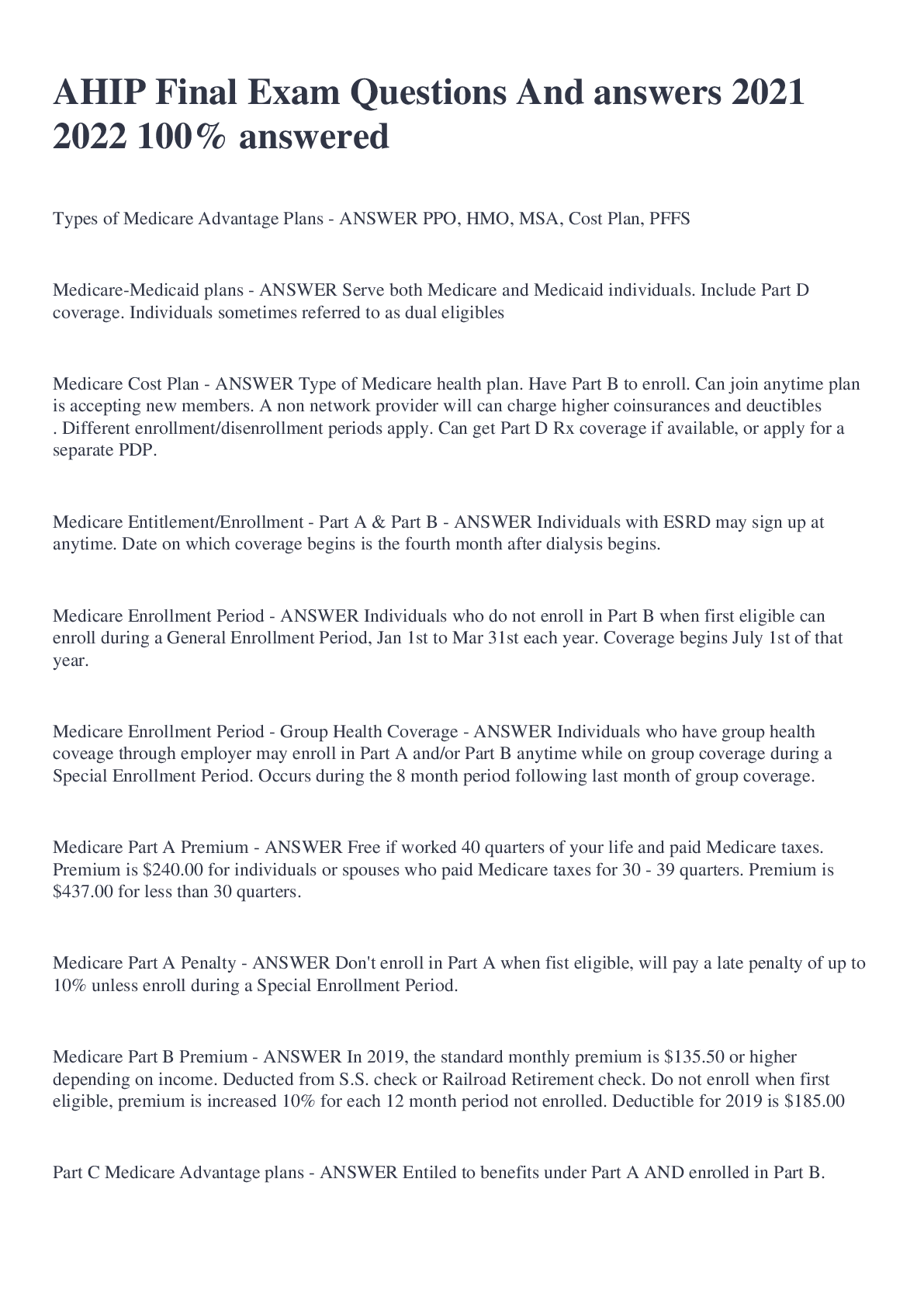
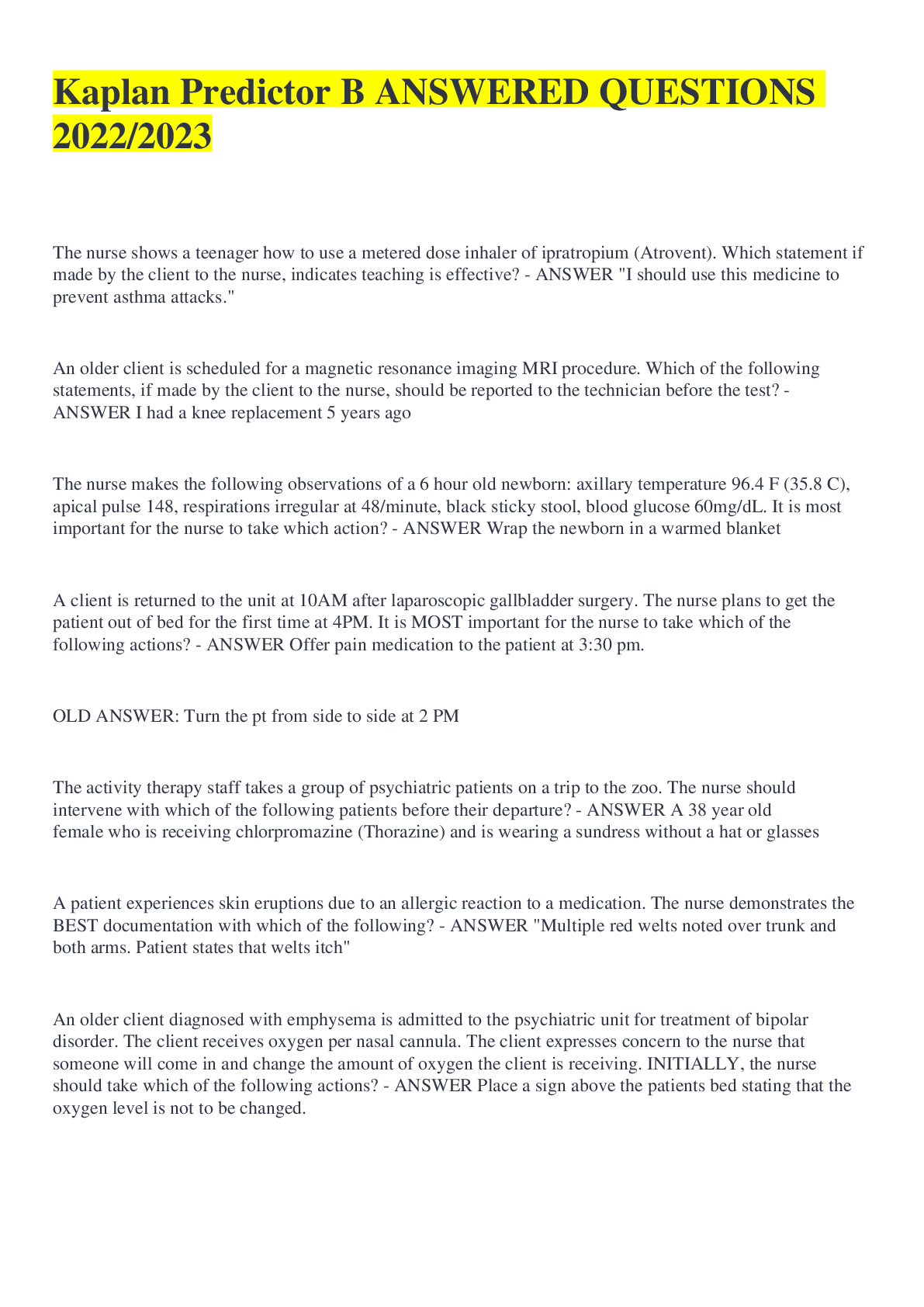
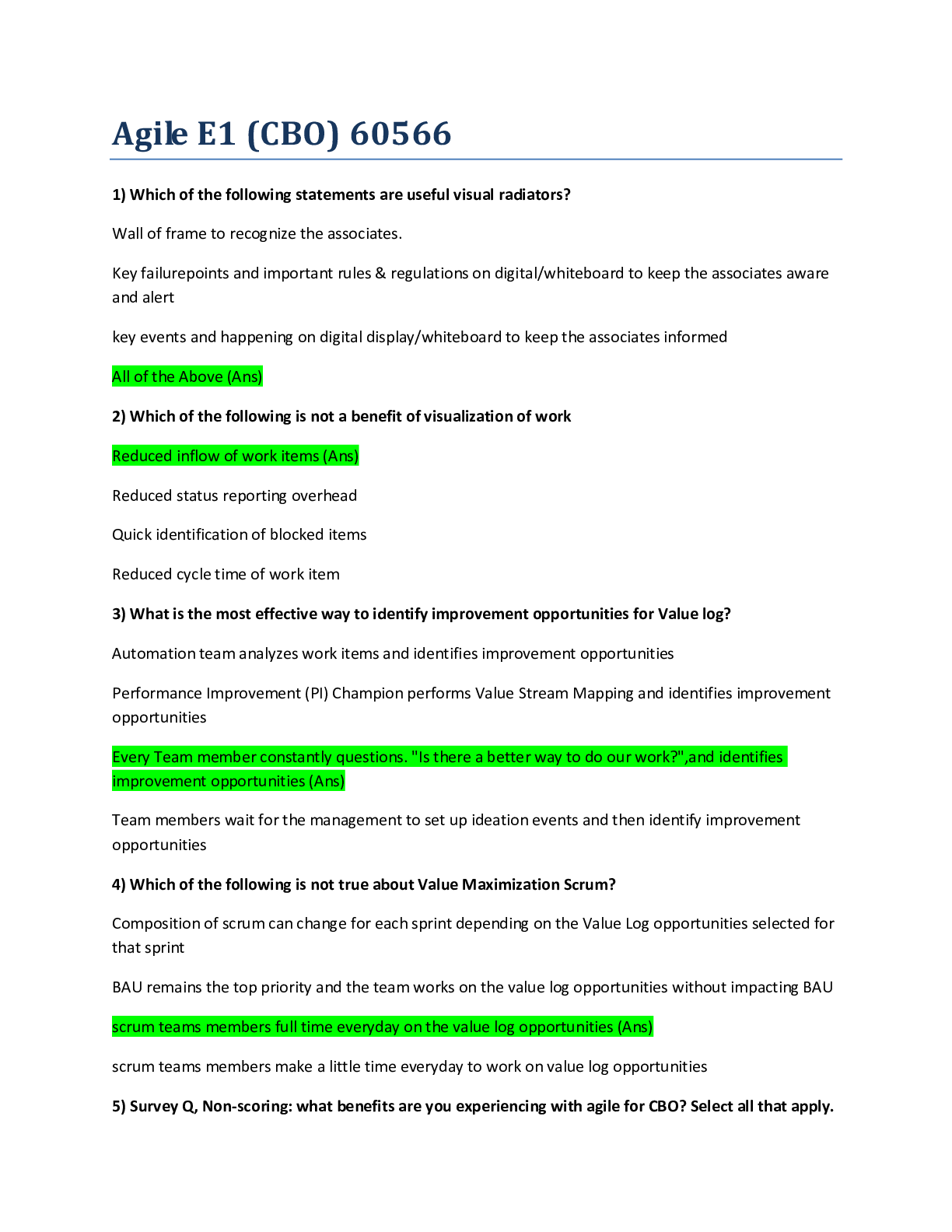
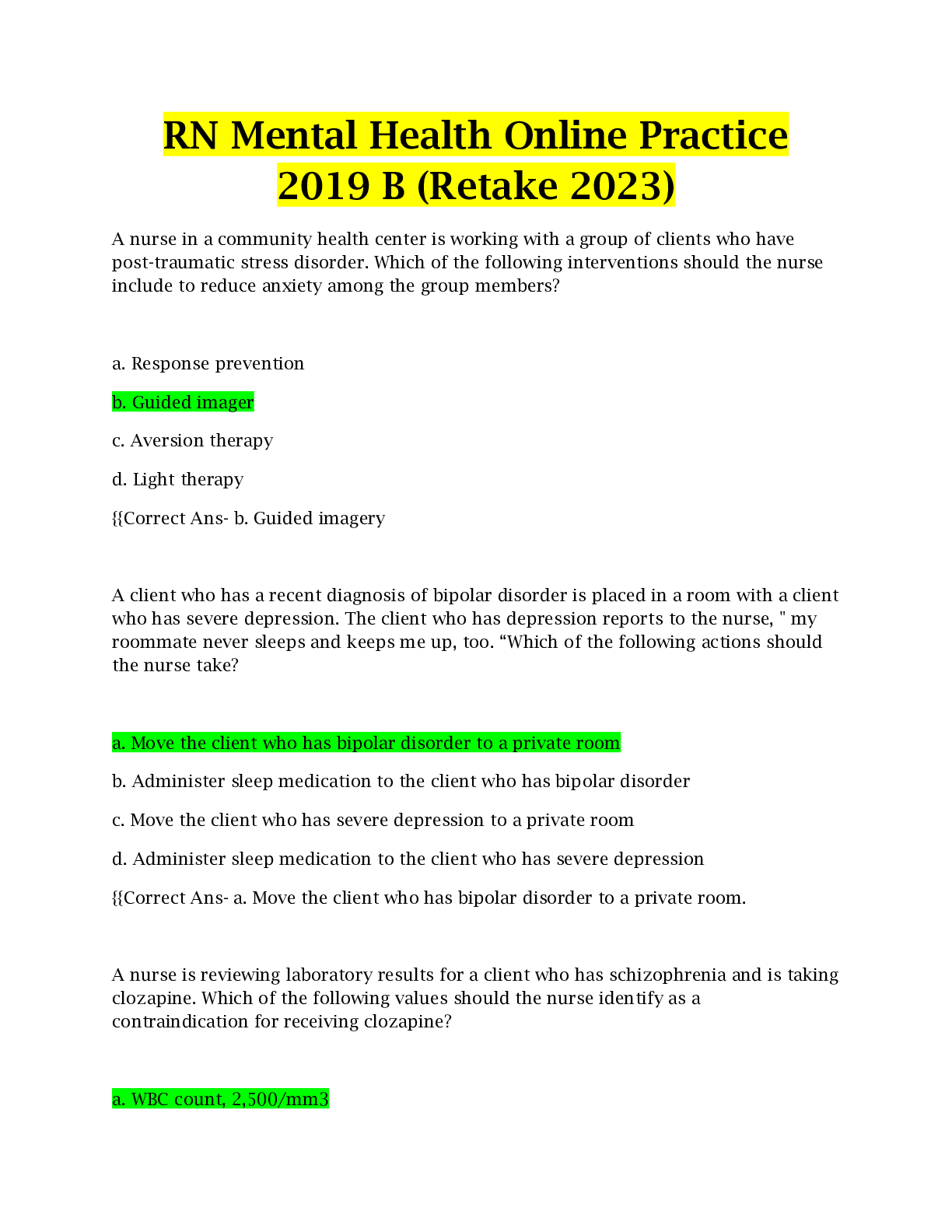
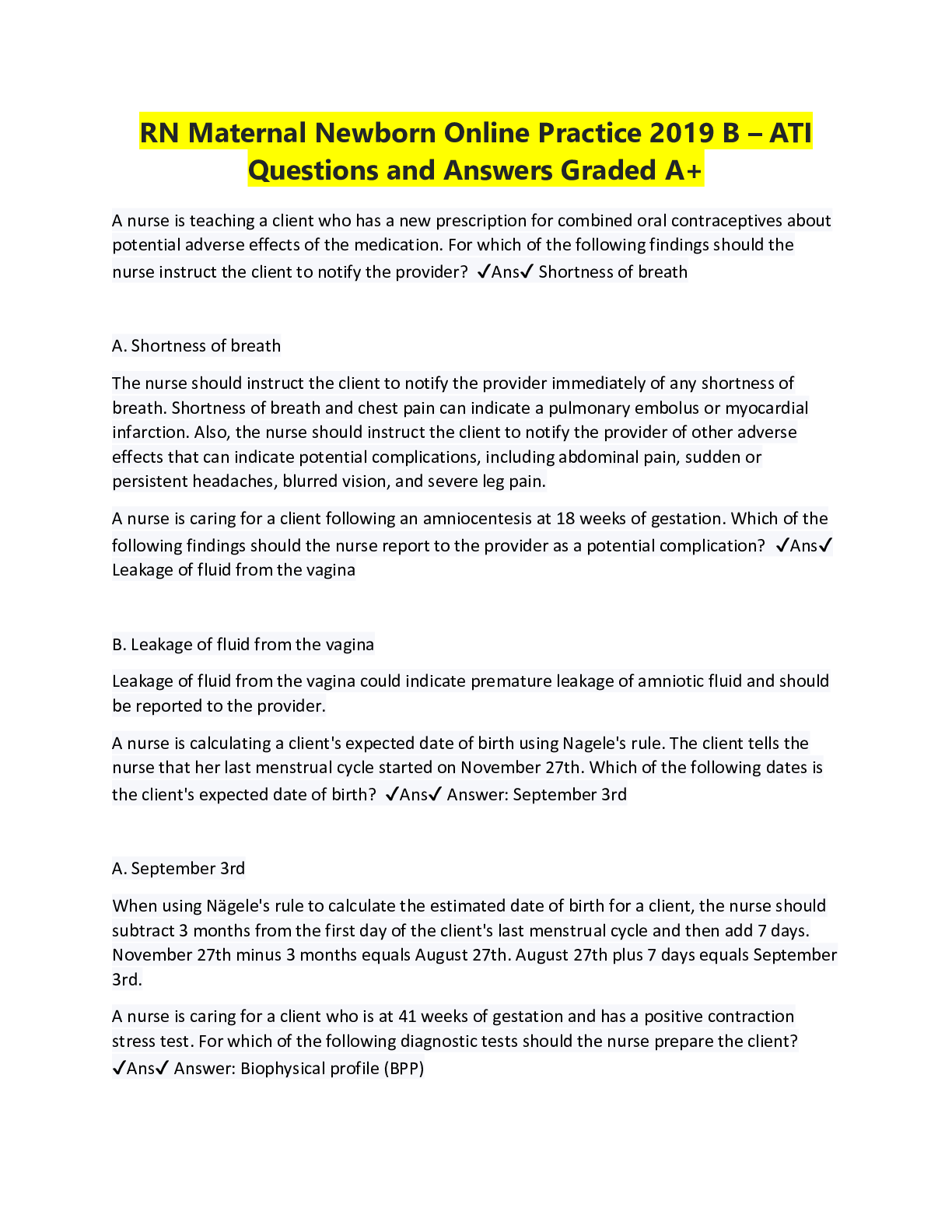
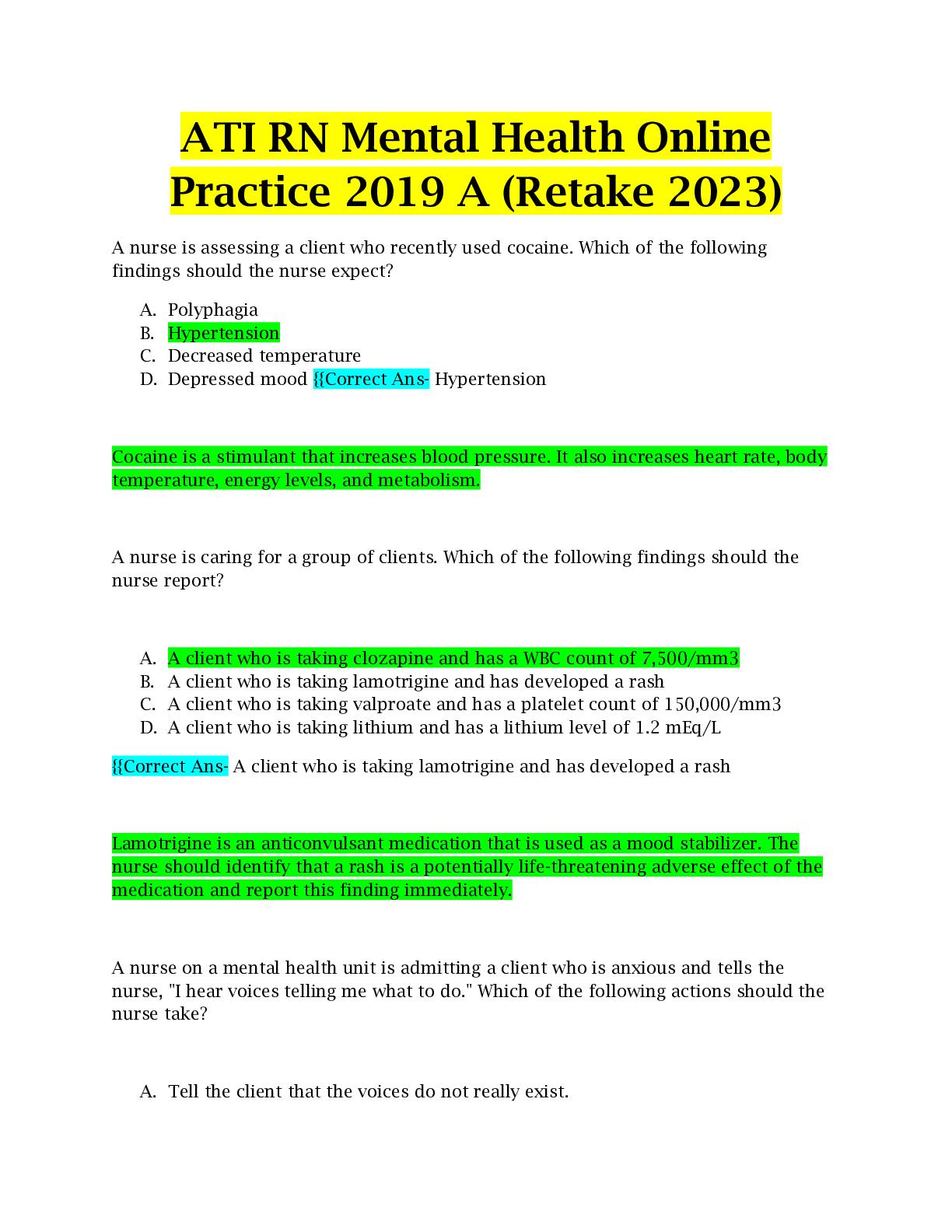

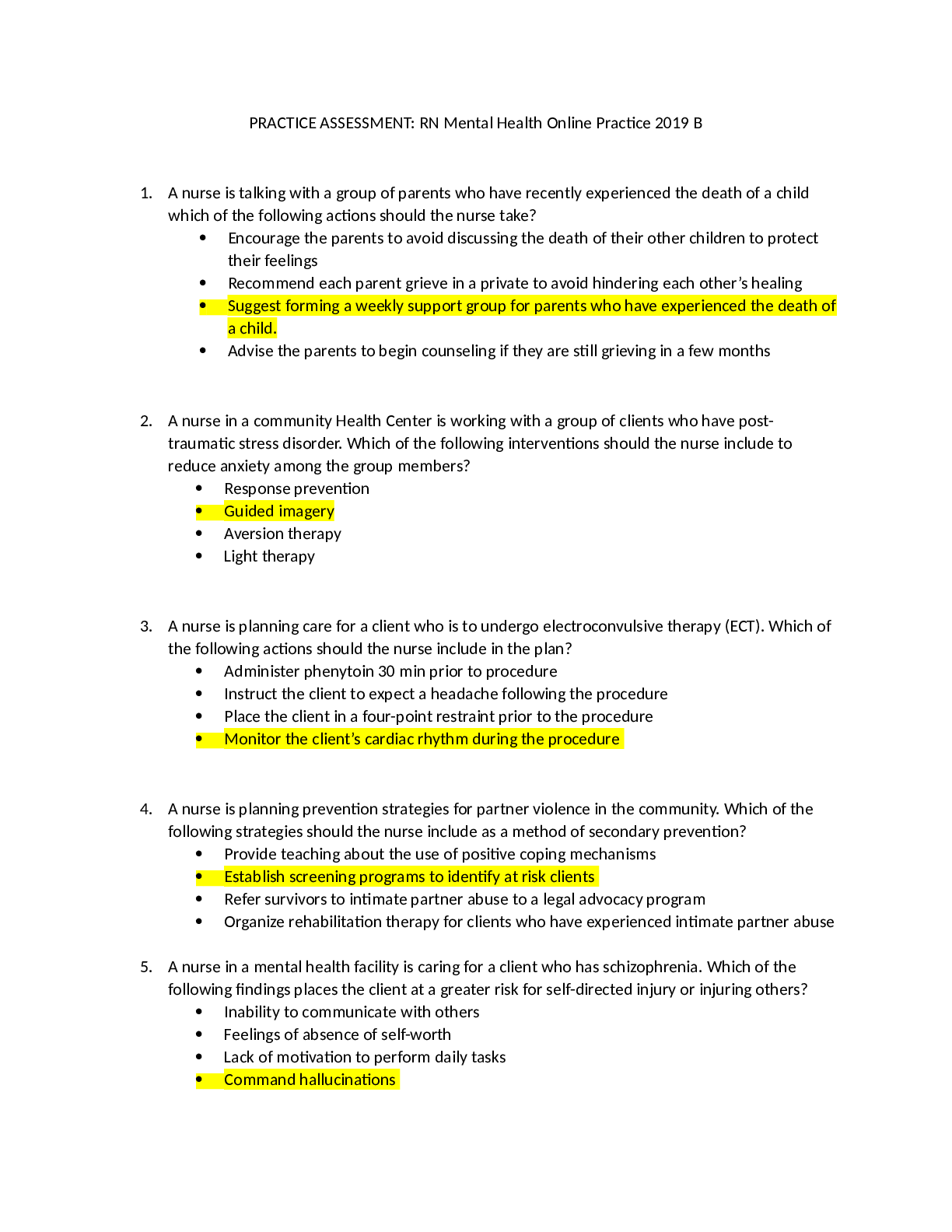
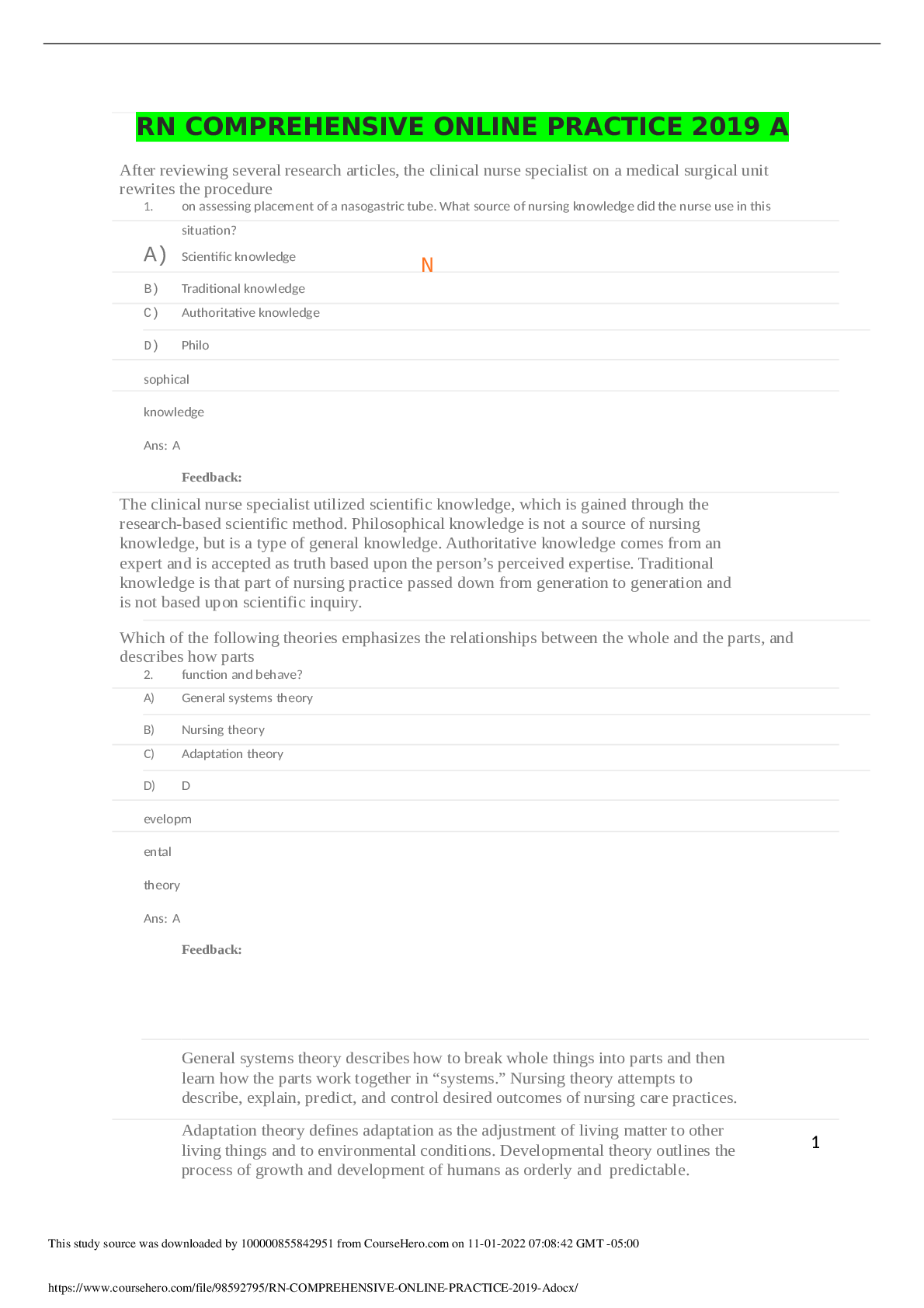
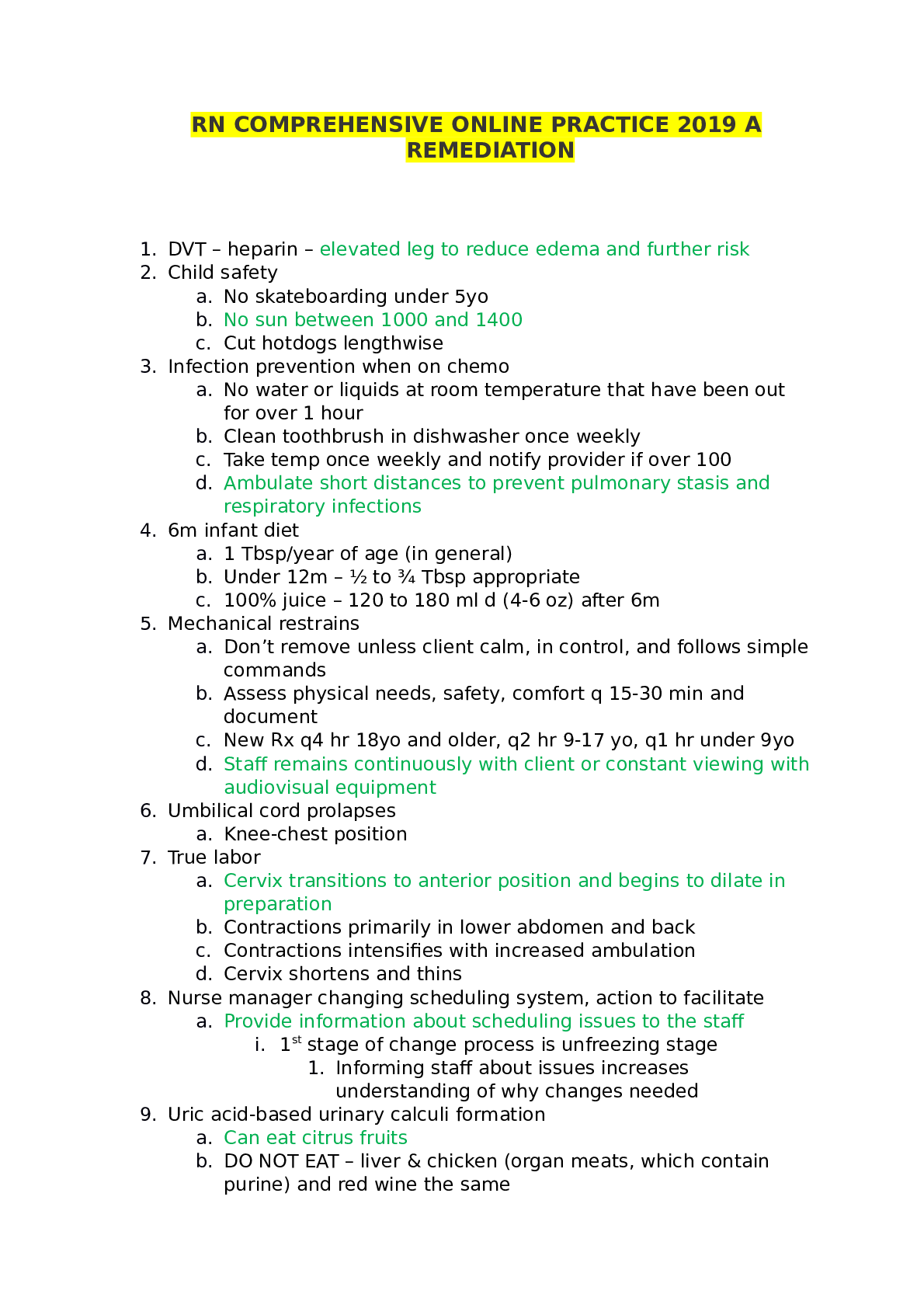
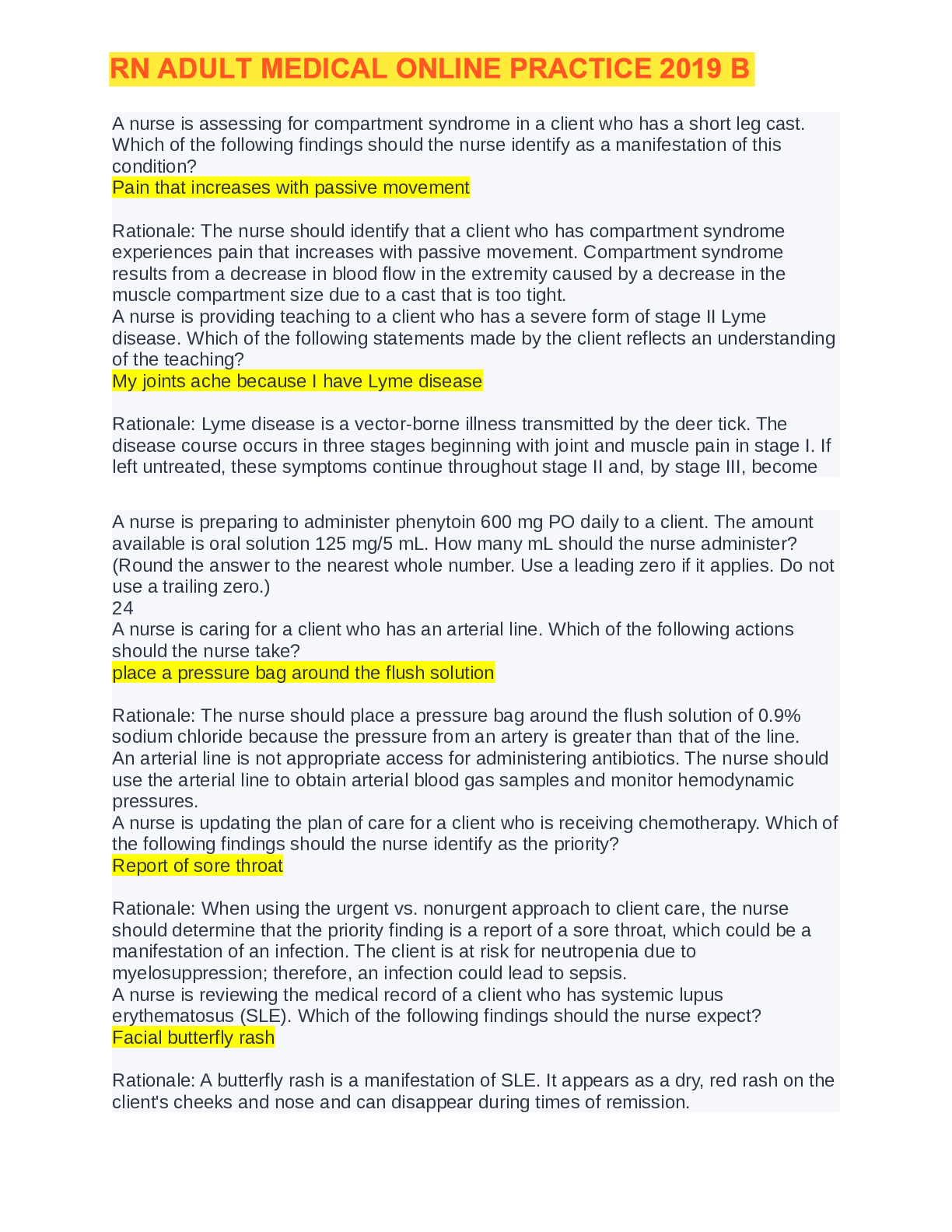
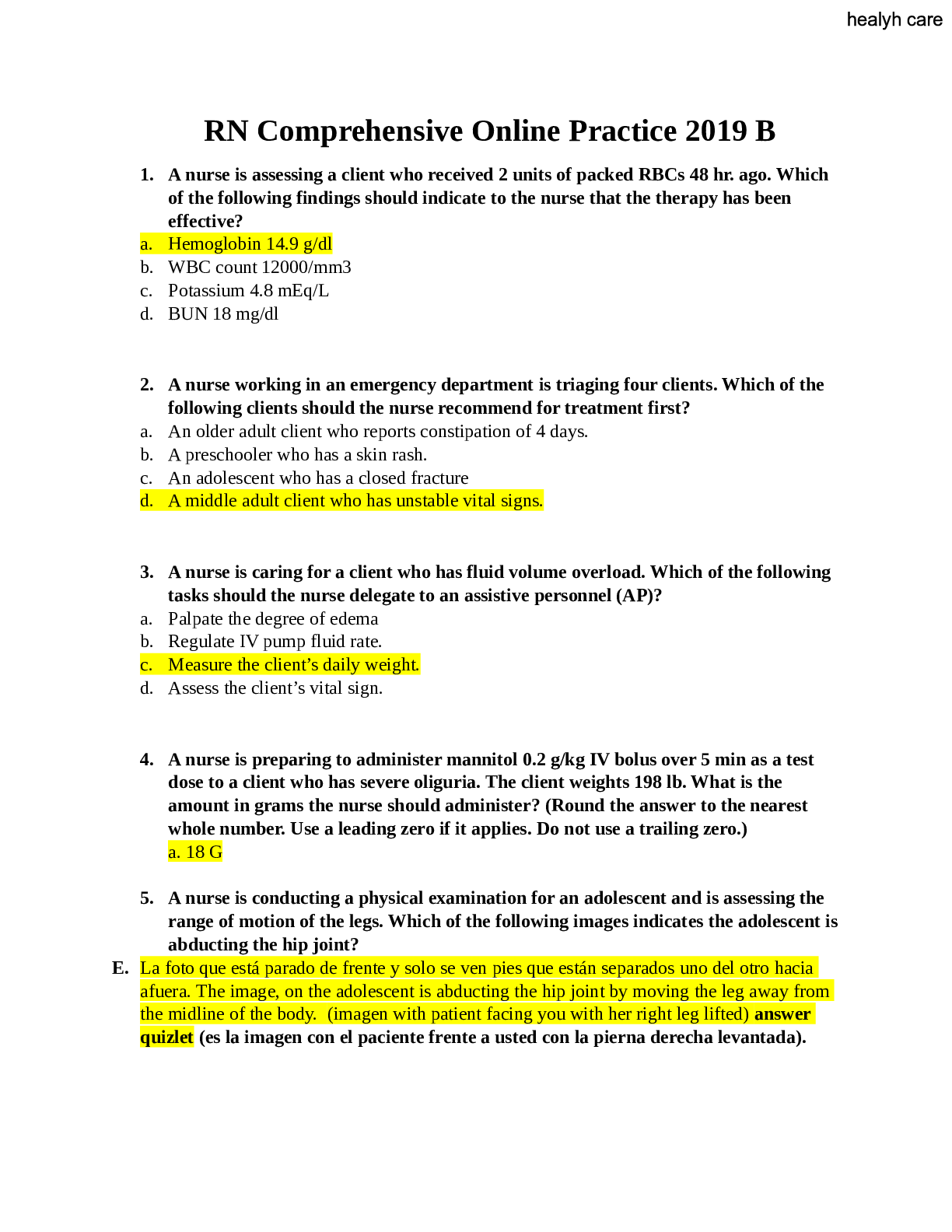


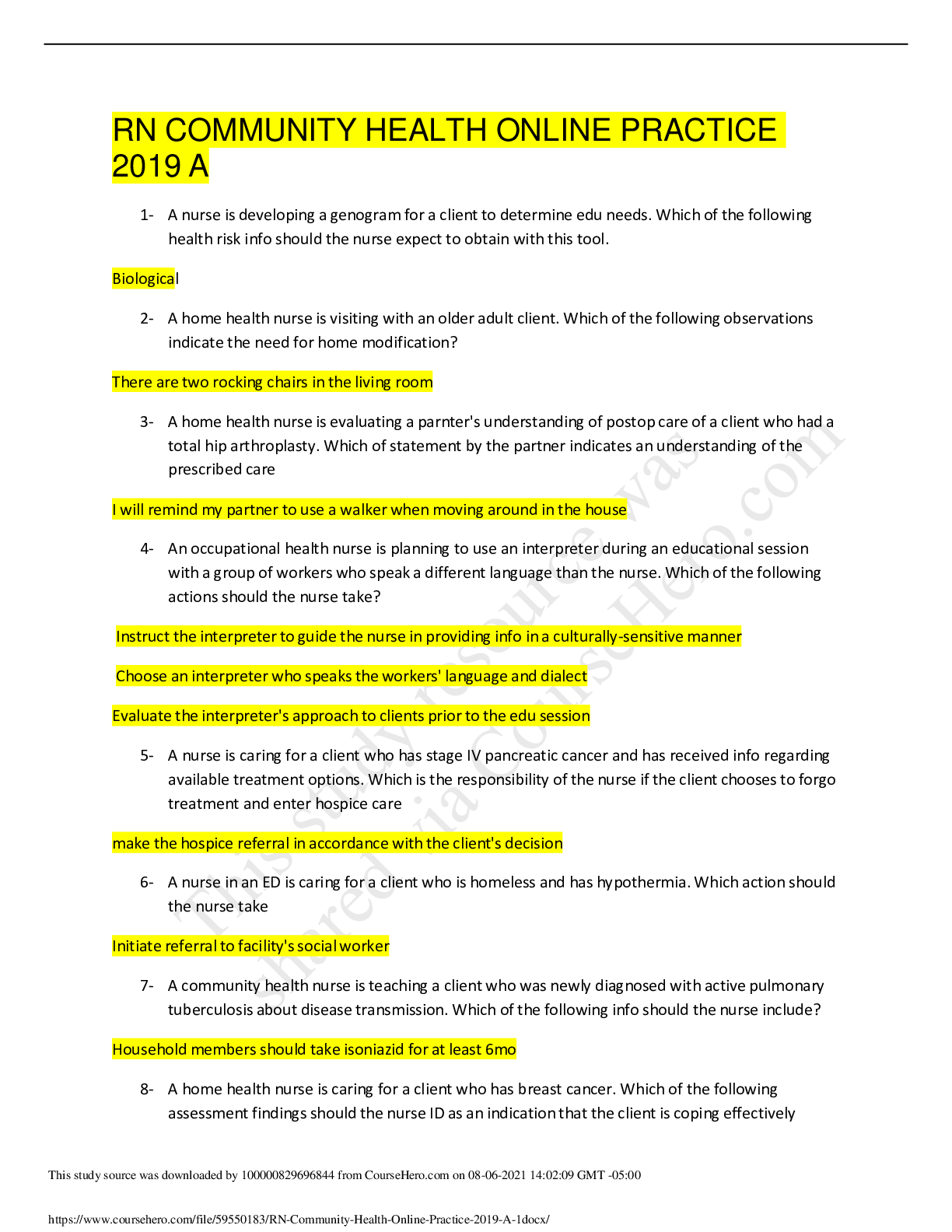
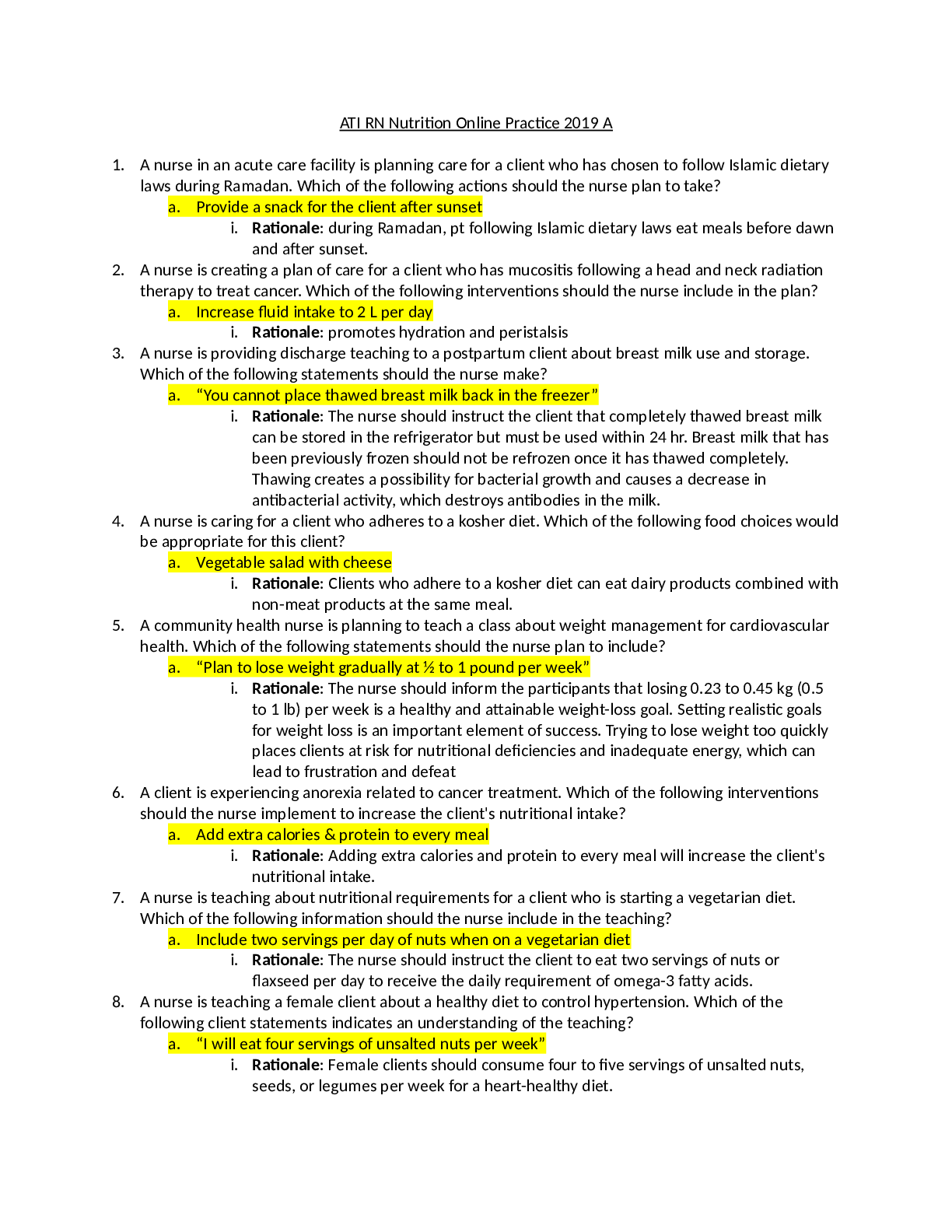
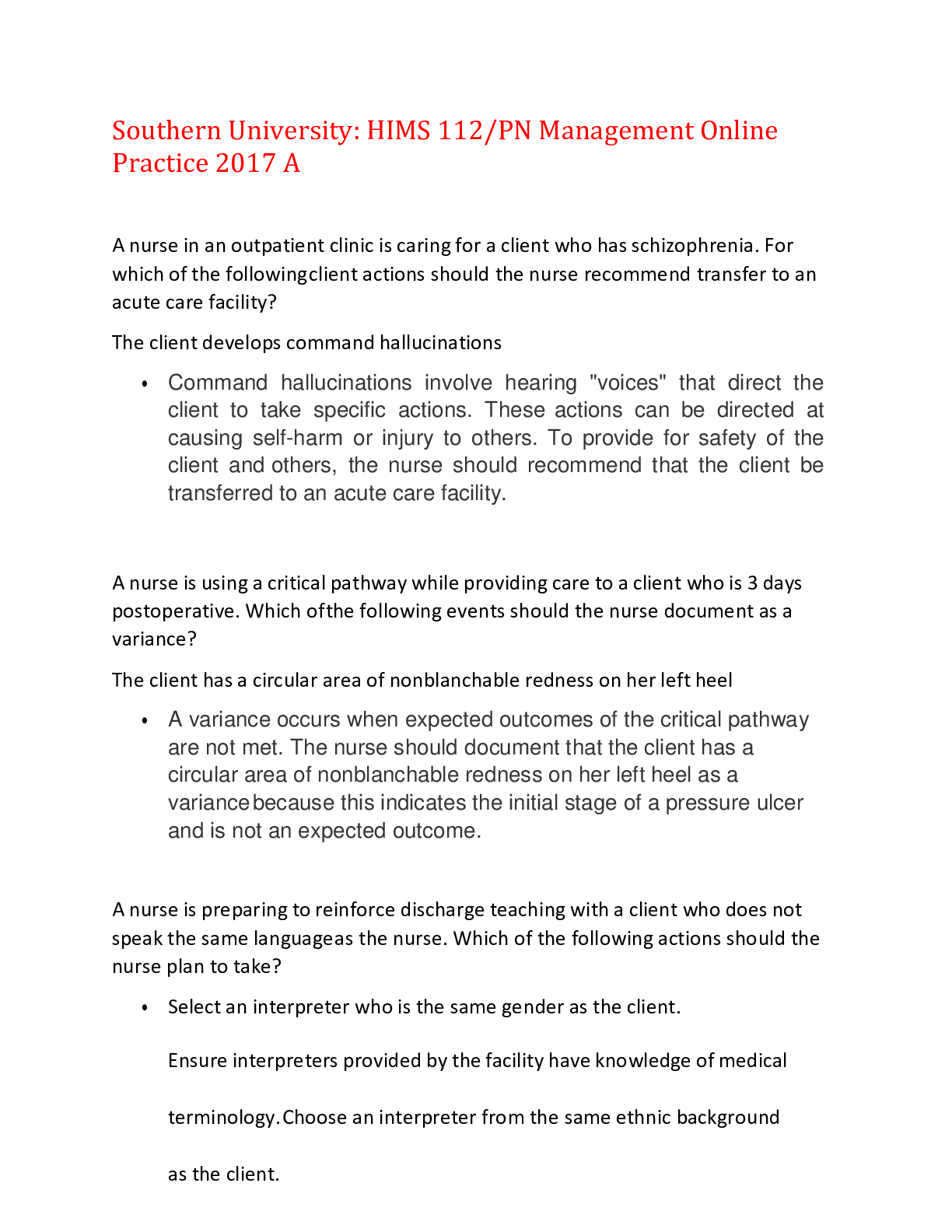
 (1).png)

